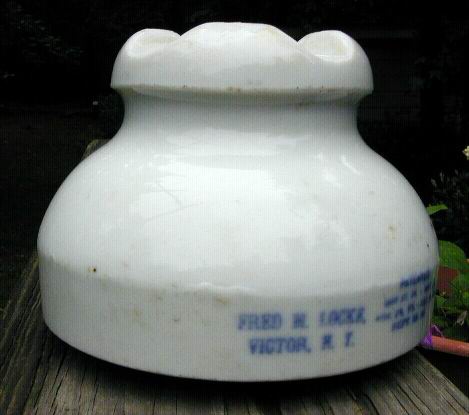New U-Chart Style
U-923F made by
Electric Porcelain & Mfg. Co.
for Fred M. Locke
Before Fred Locke opened his porcelain insulator factory in Victor, NY, he was having U-923B and U-923C cross-top insulators made for him of dry process porcelain by the R. Thomas & Sons Co. (East Liverpool, OH). This was from early 1895 until 1896 when he asked Imperial Porcelain Works (Trenton, NJ) to make the same style from higher quality wet process porcelain. Both companies made the basic U-923 style from one piece of porcelain. When the poor quality of Imperial insulators rapidly became apparent in 1897, Fred Locke went to Electrical Porcelain & Mfg. Co. also located in Trenton, NJ. That company was recently started in April 1895 making house wiring insulators from dry process porcelain. In 1897, Fred Locke worked with EPMC to develop wet process porcelain by making insulators comprised of two or three porcelain shells glazed separately, fitted together, and fired to fuse the shells into essentially one insulator. This process was known as glazewelding. Thomas later sued Fred Locke and EPMC for patent infringement on their 1898 Boch patent for "glazefilling", which used extra glaze to fill the gaps between the shells. Fred Locke and EPMC ultimately lost in 1901 and EPMC apparently went bankrupt. This whole story and much more can be found in my book, Fred M. Locke: A Biography.
Recently a unique insulator was offered for sale on eBay. It is a cross-top style similar to the U-923 series except it was made by EPMC. It was made of three shells glazewelded together (outer shell and one for each of the two inner skirts). It has been assigned a new number: U-923F. What makes this insulator more unique are the two under-glaze ink markings on the side of the skirt. The first marking is #0-5:
FRED M. LOCKE,
VICTOR, N.Y.
The second marking is a previously unreported marking which
has been assigned #5-2:
PATENTED
MAY 22, 94, - MAY 89,
NOV. 24, 96, - DEC. 15, 96,
SEPT. 28, 97.
The marking is similar to marking #5-1 which appears on U-927A and U-939. Marking #5-1 probably came later since it has Fred Locke's name incorporated in the marking. U-923F would naturally be one of the first insulator styles Fred Locke would ask EPMC to make. Since he always insisted in marking all his insulators with his name, EPMC had to use both marking stamps until the patent marking could be revised to #5-1. Note, too, that the May 89 patent date was out of order and that was corrected in the new marking, #5-1. The U-923F was probably made in early 1897 and was most likely one of the first insulators EPMC made for Fred Locke.
This lone specimen of U-923F was found recently at a sale in Middleville, NY. You never know when a new Fred Locke style will appear. There are surely more of this type out there somewhere and other unreported styles may some day show up that match odd styles that have been found in the Victor factory dump.

Note the unusually large partially open air "blister" bubble in one of the cross-top grooves. Also note the round dots in each of the four grooves which may have been caused from air vents in the mold. The insulator was made of wet process porcelain. There are two mold lines running on opposite sides from the upper edge of the tie-wire groove down to the 1" flat skirt side. One mold line runs to between the two markings. So, the insulator was pressed in a 3-part mold with the third part being the entire crown. And the 1" flat part around the skirt does not show any mold lines but there is a mold line around the insulator at the top of the 1" flat part. Apparently there was circular band that formed the bottom part of the skirt. The 1" flat section is slightly tapered inward at the bottom which would have aided removal of the band when the mold was opened up (picture the insulator being pressed upsidedown). Below is a photograph of the underside. Note the smoke soot which shows the insulator was used along a railroad.